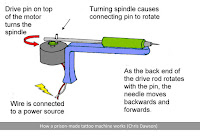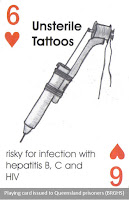Prison-Made Tattoo Machines
Tattoo machines like this were an illegal item in prison, not only because prisoners were required to maintain the same appearance during their sentence, but also because they could be used as weapons. Another important reason for restricting their use in more recent years has been to minimise the spread of communicable diseases such as hepatitis C by sharing needles. However, this did not prevent inmates from getting tattoos, and there were over 100 tattooing items in the Boggo Road collection, including both complete and incomplete machines and components, showing that tattooing was a widespread practice within the Queensland prison system.
Gallery: Prisoner-made tattoo machines (click to enlarge images)
These machines could be cobbled together using bits and pieces found around a 1980s prison. Image A (above) shows what the components were, and the list below shows where these bits and pieces came from:
- Drive rod and barrel (Pen): Issued for hobby work, etc, in cells
- Needle and connecting pin (Needle or pin): Sewing needles and pins from industry workshops; Wire (later sharpened) from workshops, or paper clips issued as stationer; Diabetic needles from the prison hospital surgery; Mathematical compass, issued for hobby work; Guitar string
- Frame (Toothbrush): Prison issue
- Connecting pin (Matchsticks): Prison issue
- Spindle (Buttons) Prison clothing
- Motor (Motor): Extracted from audio cassette players or radios (allowed in cells)
- Wiring (Electrical wiring): Same as above
- Tattoo ink (India ink, issued for hobby work in cells; Charcoal, ground from spent matches, mixed with oil; Pen ink obtained from split tube of pen and mixed with margarine)
- Binding for frame and components (Cotton thread): Prison clothing or workshops; (Adhesive tape or glue):Industry workshops
The machine worked as shown in Image B (above).
The dangers...
Apart from the obvious risk that an inmate could leave prison with awful tattoos, there are serious health risks involved with prison tattoos, as sterilising the makeshift equipment is difficult or impossible. Apart from basic skin infections, deadly diseases like hepatitis and HIV/AIDS can be passed from one prisoner to another when needles are re-used. The playing card in Image C is from a deck issued to prisoners, while the poster in Image D was also used in Queensland prisons.
These were brilliantly clever devices but potentially fatal to use.
READ MORE
Back to Prison Life
Back to the History Vault



















Leave a Comment